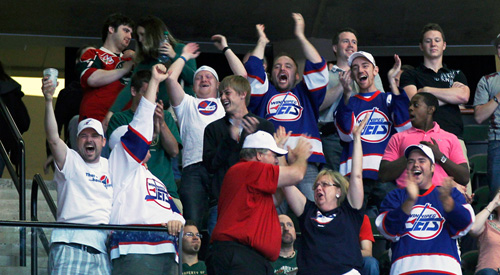
Winnipeg passed AHL test, Hamilton didn’t
It’s been a long time since 1996 – the year the city of Winnipeg witnessed their last professional hockey game at the highest level.
After losing the Jets franchise, though, the city was graced with another professional hockey team, the Manitoba Moose, who played in the now-defunct International Hockey League.
By 2001, the Moose were moved to “Tier 2” professional hockey in the form of the American Hockey League, where they continued to thrive over the years. Faithful Manitoban hockey fans flocked to the MTS Centre to support their team, not only in attendance, but more importantly, financial.
And that is where we pick up this story: Why was Winnipeg granted another NHL franchise ahead of a place like Hamilton, a promising secondary NHL market just outside of the Hockey Mecca that is the Greater Toronto Area?
Sure, the owners of the True North Sports and Entertainment group provided the NHL with a business model and financial backing to allow the other 29 NHL owners to approve the sale, but one could argue that they also simply just deserve the squad.
When the Manitoba Moose appeared as a member of the IHL in 1997, the team was near the top of league attendance. As the league went from 19 teams down to 11 before eventually folding, Manitoba boasted top-five attendance figures and profited despite continual league contraction.
[php snippet=1]
When the Moose’s ownership group made the jump to the AHL in 2001, the Manitoba faithful were, in short, happy to pay the increase in ticket prices to watch a higher quality product.
The franchise continued to serve as a model for other owners in the league as it continued to rank in the top-five in league attendance records, even if the squad never had a strong playoff performance to reflect regular season successes.
Looking over at the Greater Toronto Area – an area that seems cannot and will not support anything less than the Blue and White of the Maple Leafs – the Toronto Roadrunners were short lived, leaving town after a single season of virtually zero fan support. The GTA did not want to watch IHL hockey and, even now, the Toronto Marlies of the AHL are drawing less than the Hamilton Bulldogs (which, you’ll see, is disappointing on its own).
Popularity at the Major Junior level in the GTA isn’t much better. Few noticed when the Toronto St. Michael’s Majors were moved from St. Michael’s College to Mississauga and even if they did, refused to make the trip to watch games.
After four seasons in Mississauga, even with the Majors poised for a Memorial Cup title in 2011, the city of Mississauga left games unattended. The same phenomenon can be applied to the Brampton Battalion; if it isn’t NHL in the GTA then a relative few will support it.
Then, of course, there is Hamilton specifically – a city close to the GTA but big enough to standalone on its own merit. Despite having their own AHL franchise for 15 years now, attendance numbers have left a lot to be desired.
A comparison between attendance figures for the Manitoba Moose and the Hamilton Bulldogs is telling. In the 2005-06 season when the Moose were in their fourth season and Bulldogs their ninth, Manitoba drew a total of 323,144 fans during the regular season over their 40 home dates; an average of 8,078 fans a game.
That season, the team finished in third place in the North Division. Adversely, the Bulldogs finished sixth in the same division while averaging 5,119 fans per home game for a total of 204,760 fans in the stands.
Struggling in their division, Hamilton was clearly in a down year when those figures were taken and the product on the ice could have contributed to the lowly numbers. In contrast, however, in the very next season, the Hamilton Bulldogs won the Calder Cup after, more importantly, a third-place finish in the North while the Manitoba Moose lost to Hamilton in the second round after winning the division.
Statistically, with their division title and second-round exit, Manitoba yielded more fans than Hamilton with an average of 7,586 compared to 4,887. That the Bulldogs would go on to win the championship is a moot point, the significance being their marked improvement in the regular season and its lack of an impact on their attendance figures.
Attendance at the AHL level is just one argument of many as to why Winnipeg beat out Hamilton, the GTA and even Quebec City for the Atlanta Thrashers but it’s not to be discounted.
The NHL examines AHL markets to see how lucrative the revenue streams are in that area and determine whether or not the other 29 NHL owners can net a decent size of return by allowing a team into the test market.
When a market in Ontario with a 500,000-plus base population and roughly 2.5 million citizens within an hour’s drive can’t beat out a province that only holds one million total, the decision to relocate to Winnipeg as opposed to Hamilton was obvious.
Simply put, Winnipeg beat out Hamilton on the basis of fan support for a lesser quality hockey. The “AHL Test” was in full effect.
[php snippet=1]

